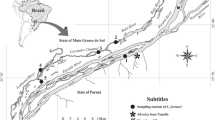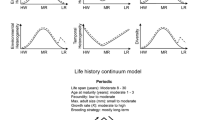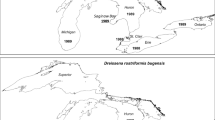Abstract
Environmental conditions may affect invasibility and potentially prevent successful invasions of the freshwater bivalve Limnoperna fortunei Dunker, 1857. However, even though the larval stage may be considered an important species’ characteristic, the invasion processes of L. fortunei are mainly evaluated using only the adult stage. Therefore, the aim of this study was to identify what, and how, environmental filters might predict the likelihood of occurrence of each of the L. fortunei larval stages. Logistic regressions were applied using the larval stages of L. fortunei as a surrogate of population age structure and the environmental variables as the main filters that potentially predicted the likelihood of the occurrence of each larval stage of L. fortunei. The turbidity predicted the occurrence of the D-shaped larvae and straight-hinged veliger stages, while the umbonated-veliger and pediveliger stages were predicted by the pH and conductivity. Finally, the phytoplankton density (diatoms) predicted the occurrence of the umbonated-veliger, pediveliger and mainly the plantigrade stages. Our findings suggested that, during larvae development, from younger to older stages, the main environmental predictor of larvae occurrence shifted from abiotic to biotic variables, indicating that larval stages are indeed an important factor that helps in the evaluation of freshwater invasibility. These findings are particularly important for floodplain systems, where flood pulse dynamics may increase propagule pressure, leading to a successful spread among habitats. Then, even though environmental filters were important to predict successful invasions, we highlight that a successful invasion might depend on the population age structure of the invading species arriving in the new habitat. Thus, successful L. fortunei invasions in floodplain systems may depend on the interaction between invasiveness, invasibility and propagule pressure.



Similar content being viewed by others
References
Agostinho AA, Thomaz SM, Gomes LC (2004) Threats for biodiversity in the floodplain of the Upper Paraná River: effects of hydrological regulation by dams. Ecohidrol Hidrobiol 4(3):255–268
Agostinho AA, Thomaz SM, Gomes LC (2005) Conservation of the biodiversity of Brazil’s inland waters. Conserv Biol 19(3):646–652
Agostinho AA, Bonecker CC, Gomes LC (2009) Effects of water quantity on connectivity: the case of the Upper Paraná River floodplain. Ecohidrol Hidrobiol 9(1):99–113
American Public Health Association (1985) Standard methods for the examination of water and waste water. Byrd Prepress, Springfield, Washington
Bicudo CEM, Menezes M (2006) Gêneros de algas continentais do Brasil: chave para identificação e descrições. Rima, São Carlos
Boltovskoy D, Cataldo D (1999) Population dynamics of Limnoperna fortunei, an invasive fouling mollusc, in the lower Paraná River (Argentina). Biofouling 14(3):255–263
Bonecker CC, Simões NR, Minte-Vera CV, Lansac-Tôha FA, Velho LFM, Agostinho AA (2013) Temporal changes in zooplankton species diversity in response to environmental changes in an alluvial valley. Limnologica 43:114–121
Bonel N, Lorda J (2015) Growth and body weight variability of the invasive mussel Limnoperna fortunei (Mytilidae) across habitat and season. Malacologia 58:129–145
Bonel N, Solari LC, Lorda J (2013) Differences in density, shell allometry and growth between two populations of Limnoperna fortunei (Mytilidae) from the Río De La Plata basin, Argentina. Malacologia 56:43–58
Byrnes JE, Reynolds PL, Stachowicz JJ (2007) Invasions and extinctions reshape coastal marine food webs. PLoS One 2(3):e295
Cataldo D, Boltovskoy D, Hermosa JL, Canzi C (2005) Temperature dependent larval development rates of Limnoperna fortunei (Mollusca, Bivalvia). J Molluscan Stud 71:41–46
Checa AG, Jimenez-Lopes C, Navarro-Rodriguez A, Machado JP (2007) Precipitation of aragonite by calcitic bivalves on Mg-enriched marine waters. Mar Biol 150(5):819–827
Codd GA, Morrison LF, Metcalf JD (2005) Cyanobacterial toxins: risk management for health protection. Toxicol Appl Pharm 203:264–272
Cuddington K, Currie WJS, Koops MA (2014) Could an Asian carp population establish in the Great Lakes from a small introduction? Biol Invasions 16:903–917
Darrigran G, Damborenea C, Greco N (2007) An evaluation pattern for antimacrofouling procedures: Limnoperna fortunei larvae in a hydroelectric power plant in South America. Ambio 36(7):575–579
Davis MA, Thompson K, Grime JP (2005) Invasibility: the local mechanism driving community assembly and species diversity. Ecography 28:696–704
Deaton LE, Derby JGS, Subhedar N, Freenberg MJ (1989) Ormoregulation and salinity tolerance in two species of bivalve mollusc: Limnoperna fortunei and Mytilopsis leicophaeta. J Exp Mar Biol Ecol 133:67–79
Ezcurra de Drago I, Montalto L, Oliveros OB (2009) Desenvolvimento e ecologia larval de Limnoperna fortunei. In: Darrigran G, Damborenea C (eds) Introdução a biologia das invasões. O mexilhão dourado na América do Sul: biologia, dispersão, impacto, prevenção e controle. Cubo editora, São Carlos, pp 77–87
Fachini A, Gazulha V, Pedroso CS (2012) Os impactos do mexilhão-dourado sobre a comunidade planctônica. In: Mansur MCD, Santos CP, Pereira D, Paz ICP, Zurita MLL, Rodriguez MTR, Nehrke MV, Bergonci PEA (eds) Moluscos límnicos invasores do Brasil: biologia, prevenção e controle. Redes Editora, Porto Alegre, pp 255–261
Jaremo J, Bengtsson G (2011) On the importance of life history and age structure in biological invasions. Ecol Model 222:485–492
Jaric I, Jacimovic M, Cvijanovic G, Knezevic-Jaric J, Lenhardt M (2015) Demographic flexibility influences colonization success: profiling invasive fish species in the Danube River by the use of population models. Biol Invasions 17:219–229
Jeppesen E, Sondergaard M, Jensen JP, Mortensen E, Sortkjaer O (1996) Fish-induced changes in zooplankton grazing on phytoplankton and bacterioplankton: a long-term study in shallow hypertrophic Lake Sobygaard. J Plankton Res 18:1605–1625
Junk WJ, Bayley PB, Sparks RE (1989) The flood pulse concept in river-floodplain systems. Can J Fish Aquat Sci 106:110–127
Karatayev AY, Boltovskoy D, Padilla D, Burlakova LE (2007) The invasive bilvalves Dreissena polymorpha and Limnoperna fortunei: parallels, contrasts, potential spread and invasion impacts. J Shellfish Res 26:205–213
Kasyanov VL, Kryuchkova GA, Kulikova VA, Medvedeva LA (1998) Larvae of marine bivalves and equinoderms. Smithsonian Institution Libraries, Washington
Kolar CS, Lodge DM (2002) Ecological predictions and risk assessment for alien fishes in North America. Science 298:1233–1236
Lodge DM, Stein RA, Brown KM, Covich AP, Bronmark C, Garvey JE, Klosiewsk SP (1998) Predicting impact of freshwater exotic species on native biodiversity: challenges in spatial scaling. Aust J Ecol 23(1):53–67
Loverde-Oliveira SM, Huszar VLM, Mazzeo N, Scheffer M (2009) Hydrology-driven regime shifts in a shallow tropical lake. Ecosystems 12:807–819
Mackie GL, Flippance LA (1983) Intra and interspecific variations in calcium cotent of freshwater mollusca in relation to calcium contento f the water. J Molluscan Stud 49:204–212
Mansur MCD, Dos Santos CP, Darrigan G, Heydrich I, Callil CT, Cardoso FR (2003) Primeiros dados quali-quantitativos do mexilhão-dourado, Limnoperna fortunei (Dunker), no Delta do Jacuí, no Lago Guaíba e na Laguna dos Patos, Rio Grande do Sul, Brasil e alguns aspectos de sua invasão no novo ambiente. Rev Bras Zool 20(1):75–84
Margalef R (1983) Limnologia. Omega, Barcelona, p 1100
McMahon RF (2002) Evolutionary and physiological adaptations of aquatic invasive animals: r selection versus resistance. Can J Fish Aquat Sci 59:1235–1244
Melbourne BA, Cornell HV, Davies KF, Dugaw CJ, Elmendorf S, Freestone AL, Hall RJ, Harrison S, Hastings A, Holland M, Holyoak M, Lambrinos J, Moore K, Yokomizo H (2007) Invasion in a heterogeneous world: resistance, coexistence or hostile takeover? Ecol Lett 10:77–94
Montalto L, Marchese M (2003) Limnoperna fortunei (Dunker, 1857) (Bivalvia: Mytilidae) tolerance to temperature and pH in experimental condition. Neotrópica 49:26–34
Morton B (1973) Some aspects of the biology and functional morphology of the organs feeding and digestion of Limnoperna fortunei (Dunker) (Bivalvia:Mytilacea). Malacologia 12:265–281
Nakano D, Kobayashi T, Endo N, Sakaguchi I (2011) Growth rate and settlement of Limnoperna fortunei in a temperate reservoir. J Molluscan Stud 77:142–148
Oliveira MD, Hamilton SK, Calheiros DF, Jacobi CM, Latini RO (2010) Modeling the potential distribution of the invasive golden mussel Limnoperna fortunei in the Upper Paraguay River system using limnological variables. Braz J Biol 3(suppl):831–840
Oliveira MD, Calheiros DF, Jacobi CM, Hamilton SK (2011) Abiotic factors controlling the establishment and abundance of the invasive golden mussel Limnoperna fortunei. Biol Invasions 13:717–729
Paolucci EM, Sardiña P, Sylvester F, Perepelizin PV, Zhan A, Ghabooli S, Cristescu ME, Oliveira MD, MacIsaac HJ (2014) Morphological and genetic variability in an alien invasive mussel across an environmental gradient in South America. Limnol Oceanogr 59(2):400–412
Rahel FJ (2002) Homogenization of freshwater faunas. Annu Rev Ecol Syst 33:291–315
Ramcharan CW, Padilla DK, Dodson SI (1992) Models to predict potential occurrence and density of zebra mussel, Dreissena polymorpha. Can J Fish Aquat Sci 49:2611–2620
Rangel TFLVB, Diniz-Filho JAF, Bini LM (2010) SAM: a comprehensive application for spatial analysis in macroecology. Ecography 33:46–50
Ricciardi A (1998) Global range expansion of the Asian mussel Limnoperna fortunei (Mytilidae): another fouling threat to freshwater systems. Biofouling 13(2):97–106
Ricciardi A, MacIsaac HJ (2000) Recent mass invasion of the North American Great Lakes by Ponto-Caspian species. Trends Ecol Evol 15(2):62–65
Roberto MC, Santana NF, Thomaz SM (2009) Limnology in the Upper Paraná River floodplain: large-scale spatial and temporal patterns, and the influence of reservoirs. Braz J Biol 69(2):717–725
Rodrigues LC, Simões NR, Bovo-Scomparin VM, Jati S, Santana NF, Roberto MC, Train S (2015) Phytoplankton alpha diversity as an indicator of environmental changes in a neotropical floodplain. Ecol Indic 48:334–341
Santos CP, Würdig NL, Mansur MCD (2005) Fases larvais do mexilhão dourado Limnoperna fortunei (Dunker) (Mollusca, Bivalvia, Mytilidae) na bacia do Guaíba, Rio Grande do Sul, Brasil. Rev Bras Zool 22(3):702–708
Sommer U (1988) Growth and survival strategies of planktonic diatoms. In: Sandgren CD (ed) Growth and reproductive strategies of freshwater phytoplankton. Cambridge University Press, New York, pp 227–260
Sousa R, Novais A, Costa R, Strayer DL (2014) Invasive bivalve in fresh water: impacts from individuals to ecosystems and possible control strategies. Hydrobiologia 735:233–251
Souza-Filho EE (2009) Evaluation of the Upper Paraná River discharge controlled by reservoirs. Braz J Biol 69:707–716
Stachowicz JJ, Byrnes JE (2006) Species diversity, invasion success and ecosystem functioning: disentangling the influence of resource competition, facilitation and extrinsic factors. Mar Ecol-Prog Ser 311:251–262
STATSOFT INC. (2005) Statistica (data analysis software system). Version 7.1. <www.statisoft.inc>. Access in: 20 de Outubro de 2007
Stevaux JC, Takeda AM (2002) Geomorphological processes related to density and variety of zoobenthic community of the upper Paraná River, Brazil. Z Geomorphol 129:143–158
Sylvester F, Dorado J, Boltovskoy D, Juárez A, Cataldo D (2005) Filtration rates of the invasive pest bivalve Limnoperna fortunei as a function of size and temperature. Hydrobiologia 534:71–80
Telesh IV, Ojaveer H (2002) The predatory water flea Cercopagis pengoi in the Baltic sea: invasion history, distribution and implications to ecosystem dynamics. In: Leppäkoski E, Gollasch S, Olenin S (eds) Invasive aquatic species in Europe. Distribution, impacts and management. Kluwer Academic Publishers, Dordrecht, pp 62–65
Ter Braak CJF, Looman CWN (1986) Weighted averaging, logistic regression and the Gaussian response model. Vegetatio 65:3–11
Thomaz SM, Bini LM, Bozelli RL (2007) Floods increase similarity among aquatic habitats in river-floodplain systems. Hydrobiologia 579:1–13
Thomaz SM, Roberto CM, Bini LM (1997) Caracterização limnológica dos ambientes aquáticos e influência dos níveis fluviométricos. In: Vazzoler AEAM, Agostinho AA, Hahn NS (eds) A planície de inundação do alto do rio Paraná: aspectos físicos, biológicos e socioeconômicos. EDUEM, Nupélia, Maringá. Cap. 13, pp 73–102
Utermöhl H (1958) Zur Vervollkommnung der quantitativen phytoplankton methodic. Mitt Int Ver Theor Angew Limnol 9:1–38
Westman K (2002) Alien crayfish in Europe: negative and positive impacts and interactions with native crayfish. In: Leppäkoski E, Gollasch S, Olenin S (eds) Invasive aquatic species in Europe. Distribution, impacts and management. Kluwer Academic Publishers, Dordrecht, pp 76–95
Acknowledgments
We are thankful to the Long Term Ecological Research Project (PELD) and to the National Council of Scientific and Technological Development (CNPq) for data collection and financial support. We are also thankful to the Research Group in Limnology, Ichthyology and Aquaculture (Nupelia) and its Limnology Laboratory for assistance in the field and laboratory work. Finally, we thank the Reviewers and Editor for their valuable suggestions.
Author information
Authors and Affiliations
Corresponding author
Rights and permissions
About this article
Cite this article
Ernandes-Silva, J., Ragonha, F.H., Rodrigues, L.C. et al. Freshwater invasibility level depends on the population age structure of the invading mussel species. Biol Invasions 18, 1421–1430 (2016). https://doi.org/10.1007/s10530-016-1091-8
Received:
Accepted:
Published:
Issue Date:
DOI: https://doi.org/10.1007/s10530-016-1091-8




